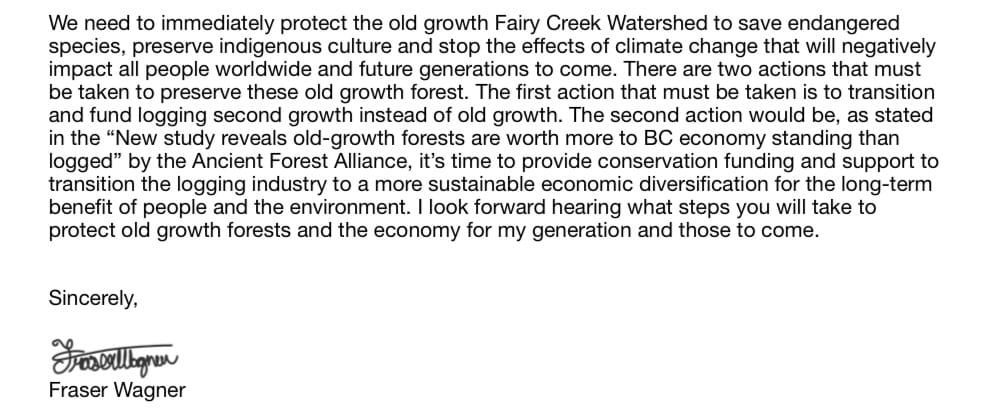
Hello and welcome! For this Humanities 9 project, we wrote a letter about an environmental issue to promote change to people who can make those changes (like a premier or minister). I wrote to Katrine Conroy, the Minister of Forests, Natural Lands and Resources to demand an immediate protection of old growth forests, specifically the unprotected forests in the Fairy Creek Watershed on Vancouver Island.
Our driving question for this project was:
How do people and the environment affect one another?
People affect the environment every day by driving, throwing out trash, polluting, planting trees, cleaning up beaches and protecting natural areas. The environment affects us everyday as well, it provides all we need, air, water, food and creates challenges like storms, floods and earthquakes. One of the first activities we did in this project that I think will do a great job at helping to answer the driving question, was to write an essay on whether people are destroyers or protectors of nature. Here’s my essay:
The first step of writing our letters was to find evidence from credible sources to support our argument. I had a lot of information about Fairy Creek from various instagram accounts like @rainforestflyingsqad and @fairycreekblocade but I realized that these sources might have a set perspective and the information might be biased. So I found a bunch of articles from CBC and The Narwhal, as well as some reports on old growth. I made notes of the main points and recorded the information about the sources in a pages document. We also did two vocabulary quizzes and practiced writing with context. These activities helped me to understand the skills in the curricular competency “how to recognize the role of context and perspective in texts.”
We did several CommonLit activities over the course of this project to strengthen our abilities to find themes and how to use evidence in our writing.
 My favourite text we read was a story called He-y, come on ou-t about a village that discovers a mysterious hole because it had a great moral about making sure to think about long term consequences. For all the activities we did, we answered multiple choice questions and paragraph responses. These helped me recognize how texts use literary devices to enhance meaning. I feel that my reading and writing abilities have greatly improved after completing the CommonLit activities and I enjoyed getting to read all the texts!
My favourite text we read was a story called He-y, come on ou-t about a village that discovers a mysterious hole because it had a great moral about making sure to think about long term consequences. For all the activities we did, we answered multiple choice questions and paragraph responses. These helped me recognize how texts use literary devices to enhance meaning. I feel that my reading and writing abilities have greatly improved after completing the CommonLit activities and I enjoyed getting to read all the texts!
We also did a 60 minute writing activity to connect the ideas and themes in the CommonLit activities with the ones in our letters. I found it a bit challenging to choose which stories to write about and which parts of my letter to connect them to. Overall though, I’m proud of how my multi-paragraph response turned out! I think I did a great job using the strategies to analyze texts to find themes in my letter to connect to the ones in the texts that we learned from the CommonLit activities. You may read my multi-paragraph response below:
The actual letter took several drafts (five in total) to complete and with very helpful constructive feedback from peers, a PLP 11 student (Holly) and teachers, my letter went from this:
To this (Click here to open PDF version):

Then we all walked down to the cove and sent our letters off in the mail!
Photos: Ms. Maxwell & Fraser W
I enjoyed learning about the environmental issues our world is facing and how to promote change! I will of course continue to learn about climate issues and keep up-to-date about the Fairy Creek blockades. Writing letters is a very important life skill and based on the way governments are dealing with climate change, I think I might be writing more letters sooner than I would have thought…
Until next time!✌️




